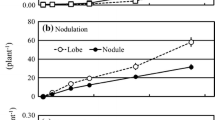Summary
In three field trials conducted during the summer season of 1986, 1987 and 1989 in an alkaline soil, 17 accessions of annual Sesbania spp. were evaluated for nodulation, N2 fixation (acetylene reduction assay), dry weight of roots and shoots, woody biomass production, and nutrient uptake. At 50 days after sowing all the accessions were effectively nodulated (average 36.4 root nodules plant-1) with a high nodule score (3.4). There was a lot of variation in nodule volume and mass and in acetylene reduction activity but not in N content (5.2%). N uptake in shoots, roots and nodules averaged 639, 31, and 13 mg plant-1, respectively, and much of the fixed N remained in shoots. Accessions of ‘S. cannabina’ complex performed better than others. S. rostrata had poor root nodulation but exhibited excellent stem nodulation (300 nodules plant-1) even though not inoculated with Azorhizobium sp. Average concentrations of N, P, K, S, Ca, and Mg in the shoots were high, at 3.2, 0.28, 1.5, 0.28, 1.5, and 0.4% respectively, and Na was low (0.15%), reflecting the usefulness of Sesbania spp. as an integrated biofertilizer source. Green matter production was 26.0 Mg ha-1 (5.9 Mg dry matter) and N uptake was 158 kg ha-1, 54 days after sowing. Average woody biomass of six accessions at maturity, 200 days after sowing, was high (19.9 Mg ha-1), showing its potential for shortterm firewood production. Total nutrient uptake for production of woody biomass (200 days of growth) was no more demanding than growing the plant to the green-manuring stage of 50–60 days' growth.
Similar content being viewed by others
References
Adebayo A, Watanabe I and Ladha JK (1989) Epiphytic occurence of Azorhizobium caulinodans and other rhizobia on host and non-host legumes. Appl Environ Microbiol 55:2407–2409
Becker M, Ladha JK, Ottow JCG (1990) Growth and N2 fixation of 2 stem nodulating legumes and their effects as green-manure on lowland rice. Soil Biol Biochem 22:1109–1119
Bergerson FJ (1980) Methods for evaluating biological nitrogen fixation. John Wiley, Chichester
Beri V, Meelu OP, Khind CS (1989) Biomass production, N accumulation, symbiotic effectiveness and mineralization of green manures in relation to yield of wetland rice. Trop Agric (Trinidad) 66:11–16
Bhardwaj KKR, Dev SP (1985) Production and decomposition of Sesbania cannabina (Retz.) Pers. in relation to its effect on the yield of wetland rice. Trop Agric (Trinidad) 62:233–236
Brockwell J (1980) Experiments with crop and pasture legumes: Principles and practice. In: Bergerson FJ (ed) Methods for measuring biological nitrogen fixation. John Wiley, Chichester, New York
Evans DO, Rotar PP (1987a) Sesbania in agriculture. Westview Press, Boulder, Colorado
Evans DO, Rotar PP (1987b) Productivity of Sesbania species. Trop Agric (Trinidad) 64:193–200
Ghai SK, Batra L, Rao DLN (1984) Studies on dinitrogen fixation by Rhizobium spp. in association with Sesbania spp. in alkali soils. In: Annual Report, Central Soil Salinity Res Inst, Karnal, India, pp 65–67
Ghai SK, Rao DLN, Batra L (1985) Comparative study of the potential of sesbanias for green manuring. Trop Agric (Trinidad) 62:52–56
Ghai SK, Rao DLN, Batra L (1988) Nitrogen contribution to wetland rice by green manuring with Sesbania sp. in an alkaline soil. Biol Fertil Soils 6:22–25
Hesse PR (1971) A text book of soil chemical analysis. John Murray, London
Ladha JK, Watanabe I, Saono S (1988) Nitrogen fixation by leguminous green manure and practices for its enhancement in tropical lowland rice. In: Sustainable agriculture: Green manure in rice farming. Int Rice Res Inst, Los Baños, Phillipines, pp 165–183
Pareek RP, Ladha JK, Watanabe I (1990) Estimating N2 fixation by Sesbania rostrata and S. cannabina (Syn. S. aculeata) in lowland rice soil by the 15N dilution method. Biol Fertil Soils 10:77–88
Rao DLN (1986) Sesbania for green manuring. Better farming in salt affected soils, no. 6, Central Soil Salinity res Inst, Karnal, India
Rao DLN, Gill HS (1986) Nitrogen fixation and biomass production by Sesbania spp. In: Annual Report, Central Soil Salinity Res Inst, Karnal, India, pp 77–88
Singh NT (1984) Green manures as source of nutrients in rice production. In: Organic matter and rice. Int Rice Res Inst, Los Baños, Phillipines, pp 217–288
Author information
Authors and Affiliations
Rights and permissions
About this article
Cite this article
Rao, D.L.N., Gill, H.S. Nitrogen fixation, biomass production, and nutrient uptake by annual Sesbania species in an alkaline soil. Biol Fertil Soils 15, 73–78 (1993). https://doi.org/10.1007/BF00336293
Received:
Issue Date:
DOI: https://doi.org/10.1007/BF00336293



